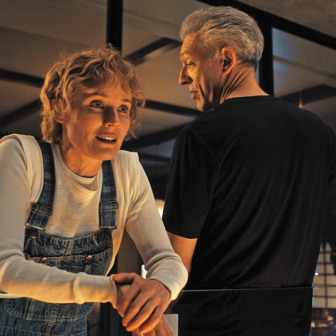Thirty-five years ago, commenting on the critical success of several recent Australian features, the ABC critic John Hinde (1911–2006) wrote that they had “shifted the sense of the Australian image towards an idea of excellence to a quite extraordinary degree.” He cited Newsfront, My Brilliant Career and, less credibly, Peter Weir’s confused and inflated Last Wave. He was less concerned, however, with commentary on particular cinematic works than with the social and cultural conditions that allowed them to come into existence. Against all the dominant thinking of the time about film-making in Australia, obsessively auteur-director centred as it was, Hinde insisted that “no society has acquired its own nationally expressive and nationally loved cinema unless the society itself has been looking, usually desperately, for new directions.” He knew whereof he spoke, then in the late 1970s; we – that is, lots of us – had lived through the ground-breaking late 1960s, the three years of the Whitlam government, and the great public trauma, the undismissable Dismissal. The shapes of major conflicts were open and visible, and the clocks would not be turned back.
Hinde took pleasure in reminding us that it was the maverick John Gorton, a Liberal PM who liked westerns, and not the culturally higher-minded Whitlam, who kickstarted the film industry revival; and that with all the tastefulness of the prestige costume dramas – Picnic at Hanging Rock, My Brilliant Career and the rest of them – the real vitality was in the Alvin Purples and Barry McKenzies. There, Hinde argued, we had a popular genre that needed time to grow, but was “suppressed by the snobberies of a minority that didn’t need them.” In the decades since he wrote, the outback horror film has taken over from Alvin and Bazza; the life of Australian film-making is with television and documentary, and not least with the eloquent short sketches, fiction, animation and film-essay that fill the programs of Tropfest. It’s with Jack Irish, and most vividly with Redfern Now. The hardest and most expensive project is still to make a full-scale drama that fills the screen convincingly for two hours, playing to about a hundred people at a time, three or four sessions a day in the multiplex.
The centre of John Hinde’s argument was always that such an enterprise could only work when it – the feature film – emerged to meet a real need within a population; he thought that cinema must draw its life from forces at work in the audience. “Cinema,” in Hinde’s essays, wasn’t the same as “film industry,” though it could well be dependent on there being an industry as the empowering framework. He was writing and broadcasting in a time when, in the excited onrush of the revived industry, aspirations toward high-end cinema were palpable everywhere; the acknowledged principals were directors, would-be auteurs. The French term had currency – and while the industry’s commercial imperatives exerted their force, the director claimed the prestige of the artist at the centre of the enterprise. This was widely acknowledged, but Hinde, in a typically benign fashion from his seat in the ABC, contested all that; he thought that the films of the new industry, struggling for its foothold, had above all to be written, devised and developed from their necessary, central concepts; written and produced, with firm guiding hands on budgets and schedules.
When a new Australian feature arrives, Hinde’s old questions come back into play; in what ways did this film, Looking for Grace, need to arrive and claim its place? It comes from the production team of Japanese Story (2003), with Sue Brooks as both director and writer. It’s not a cross-cultural story; the Aboriginal police officer plays his part without identity issues. The search for the runaway teenager has its place in the wider family story: the spaces between the parents, between them and their adolescent daughter; the problems for a middle-aged man of sexuality, getting older, self-acceptance. Richard Roxburgh communicates those so finely that you can suspend judgement – almost, if it weren’t for the eloquence of Radha Mitchell in the mother’s role; she is the one grown-up in the story, visibly isolated in her adulthood. Their drama is set in wide-open West Australian spaces, but I can’t see the high and wide angles on the wheatfields, the solitary car spinning across the view, as in any way metaphoric. Young Grace (Odessa Young) is trying to cross the distance between home in suburban Perth and Ceduna, where she and her friend plan on reaching a rock concert; the friend gives up and turns back, while Grace tangles disastrously with a handsome young exploiter.
The central problem, however, is not the pursuit, but the inescapable family itself. Elizabeth Drake’s music, subtle and discreet, precludes identification with any of the three; we’re being invited to watch a family unravelling, and perhaps, at a cost, being put back together. If such a film is needed, in the sense that John Hinde argued, this one exhibits a difficult, contemporary kind of courage; it places middle-class white dilemmas at the centre. We’re not now in Aboriginal Australia, nor in Asghar Farhadi’s Iran (vide The Past); for the audience, or most of it, the suburban world of this couple, these parents, is uncomfortably close at hand. Hinde argued for attention to what he called, variously, “cultural exactitude” or “cultural precision”; he believed that the sexual anxieties expressed in the Barry and Alvin genres might productively have been explored much further than they were – but that story “was left to go back where it came from.”
With that in mind, we could take another look at Grace’s run into the Western Australian salt flats; not to overload it with symbolic meanings, but rather to suggest that her desire – however unfocused – for a wider life than the one on offer had its own validity. Absconding teenagers aren’t wrong about everything.
In the upsurge of publishing about film industries and cinema, we have Jane Mills and Currency Press’s series of Australian screen classics (I speak as a grateful contributor), and the excellent, developing three-volume series organised by Noel King and Deane Williams, Australian Film Theory and Criticism. John Hinde’s invaluably provocative Other People’s Pictures (ABC Books, 1981) is all but forgotten. It was a cheaply produced and poorly bound volume; my copy, and that of a friend, are falling to bits in their covers. Reprinting and revival are very much in order, and I hear that the ABC is still in the publishing business.





